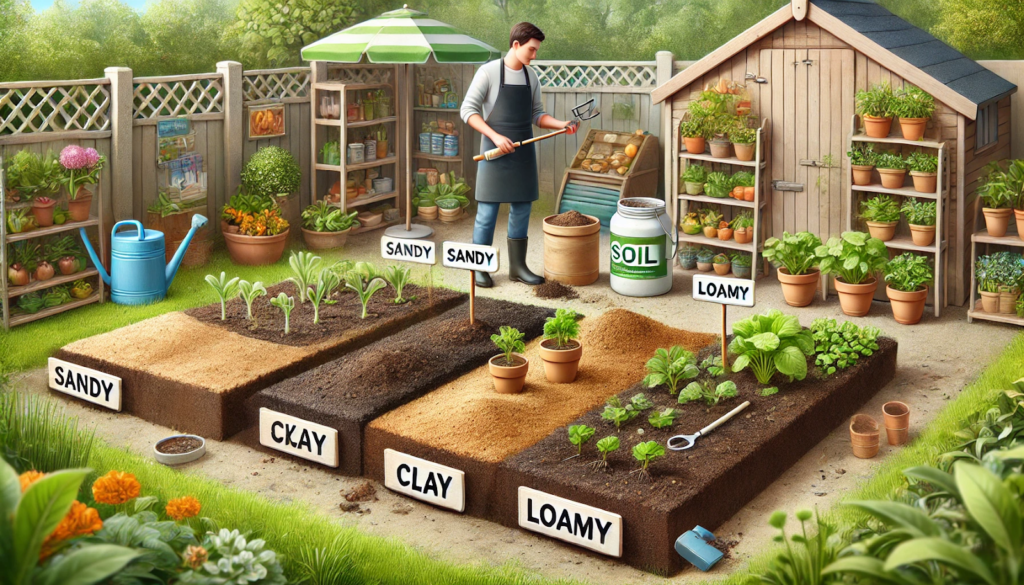Selecting the appropriate soil is fundamental to the success of your home garden. Soil provides essential nutrients, water, and support for plant roots. Understanding the different types of soil and their properties will help you make informed decisions, ensuring your plants thrive.
Understanding Soil Composition
Soil is composed of mineral particles, organic matter, water, and air. The balance of these components determines the soil’s texture, structure, and fertility.
- Mineral Particles: Sand, silt, and clay are the primary mineral components.
- Sand: Large particles that create a gritty texture and allow for good drainage but poor nutrient retention.
- Silt: Medium-sized particles that feel smooth and hold moisture better than sand.
- Clay: Small particles that are sticky when wet and compact easily, leading to poor drainage but high nutrient retention.
- Sand: Large particles that create a gritty texture and allow for good drainage but poor nutrient retention.
- Organic Matter: Decomposed plant and animal material that enriches the soil with nutrients and improves its structure.
- Water and Air: Vital for root respiration and nutrient uptake. Proper soil structure ensures a balance between moisture retention and drainage.
Identifying Your Soil Type
Determining your garden’s soil type is the first step in choosing the right soil for your plants. Here’s how you can assess it:
- Visual Inspection: Observe the soil’s color and texture. Dark, crumbly soil often indicates high organic content, while light-colored, sandy soil suggests low fertility.
- Feel Test: Moisten a handful of soil and rub it between your fingers. Sandy soil feels gritty, silty soil feels smooth, and clay soil feels sticky.
- Jar Test: Fill a clear jar halfway with soil, add water, shake well, and let it settle. The layers that form will indicate the proportions of sand (bottom), silt (middle), and clay (top).
Matching Soil to Plant Needs
Different plants have varying soil preferences. Understanding these can help you tailor your soil to meet specific plant requirements.
- Vegetables: Most vegetables prefer well-draining, loamy soil rich in organic matter. Loam is a balanced mix of sand, silt, and clay, offering good drainage and nutrient retention.
- Cacti and Succulents: These plants thrive in sandy soil that drains quickly, preventing root rot.
- Perennials and Shrubs: Many perennials and shrubs are adaptable but generally prefer loamy soil with moderate fertility.
- Acid-Loving Plants: Plants like azaleas and blueberries require acidic soil with a pH between 4.5 and 5.5.
Improving Your Soil
If your native soil doesn’t meet the needs of your plants, you can amend it to enhance its properties.
- Adding Organic Matter: Incorporate compost, aged manure, or peat moss to improve soil structure, fertility, and moisture retention.
- Adjusting pH Levels: Use lime to raise the pH (make it more alkaline) or sulfur to lower it (make it more acidic), depending on your plants’ preferences.
- Enhancing Drainage: For clay-heavy soils, add sand and organic matter to improve drainage. Raised beds can also help prevent waterlogging.
- Retaining Moisture: In sandy soils, increase organic matter content to enhance moisture retention and nutrient availability.
Using Commercial Potting Mixes
For container gardening or starting seeds, commercial potting mixes can provide an optimal growing medium.
- Seed-Starting Mixes: Lightweight and fine-textured to support delicate seedlings.
- Potting Soils: Formulated for container plants, these mixes often contain peat, perlite, and vermiculite to balance moisture retention and aeration.
- Specialized Mixes: Available for specific plant types, such as orchids or succulents, tailored to their unique soil requirements.
Regular Soil Testing
Conducting regular soil tests helps monitor nutrient levels and pH, allowing you to make informed amendments. Soil test kits are available at garden centers, or you can send samples to a local extension service for analysis.
Conclusion
Choosing the right soil is a cornerstone of successful gardening. By understanding your soil’s composition and matching it to your plants’ needs, you create a foundation for healthy growth and bountiful harvests. Regular assessment and improvement of your soil will ensure your garden remains productive and vibrant season after season.






